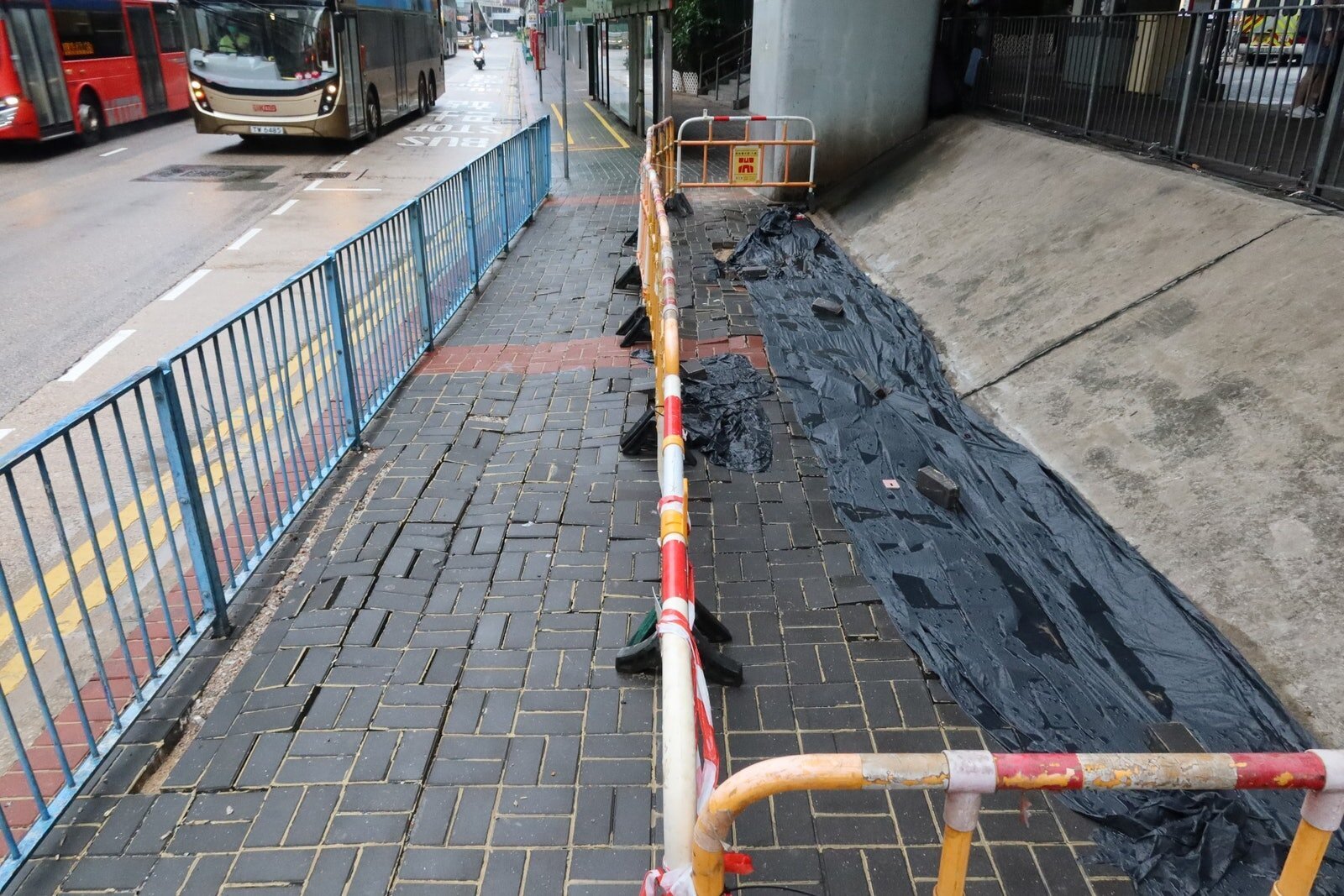路磚雖小,足以影響整個城巿|Small Bricks Big Impact: a closer look at Hong Kong’s pavement





雨季來臨,香港在6月經歷了3年來第一場黑雨,水浸過後,觀塘行人路上用膠水加固過的路磚,大面積地被連根拔起,引起吉人的一番討論:以膠水封死路磚之間的罅隙,會否阻礙路面排水?路政署澄清,雨水主要經排水渠排走,路磚或混凝土鋪路皆不會影響排水;不過,也有工程師指出,當水壓大過路磚的重量,而路磚罅隙又被封死,會造成整片路磚浮起。
路磚雖小,但鋪路究竟用什麼方法、材料,看來不止有美化道路的作用,還足以影響整個城巿的建設系統和生態。我們在討論之前,不如先回到基本,了解一下香港街道的路面:
全港換地磚
香港的行人路,以往大多用混凝土鋪建,根據路政署的文件,1980年代初,香港逾九成行人路用混凝土,其餘則用上人造鋪地石、混凝土磚和混凝土板等。其後,路政署為減少經常挖地而產生的建築廢料和噪音,開始在行人路試用路磚。
路磚貴過混凝土
按2000年工務局的數字,當時混凝土行人路每平方米建築成本是58元,普通路磚則為97元。不過,路磚在掘路、修路後可多次重用重鋪,維修成本則比混凝土低。
工業區少用路磚
路磚主要用於旅遊區、商業區和行人專用區的行人路,而因為考慮到承重問題,工業區和違法泊車嚴重的區域,則大多維持使用混凝土。
壽命十年
路磚的壽命,一般而言為大約十年,不過也要視乎所用物料的種類、行人流量及周圍環境。
鋪磚結構
以路磚鋪建的行人路,結構分為四層:最底層為泥土,上面為碎石路基層(granular sub-base),再上層是細沙墊層(sand bedding),最上層為路磚。路磚之間的接縫,則以細沙填入。
像吸水海綿的路面
傳統的道路鋪面,使用的混凝土一般都不透水。遇上大雨,路面的積水主要靠路邊的水渠排走。至1970年代,美國開始研究透水混凝土,及後德國亦開始廣泛運用,以粗骨料、水泥和膠結劑拌製,製成的混凝土有類似蜂窩狀結構的孔穴,讓雨水可以穿透混凝土。除了透水混凝土,以路磚鋪成的路,水也可以從磚縫滲透,不過是否能有效排水,磚下的地基是關鍵,否則長期經過洗刷的地基容易被掏空,下雨天,一踩就水花四濺。
鋪路也講環保
當年路政署為行人路換上路磚時,常強調其中一個優點是路磚比混凝土環保,一來掘路時路磚可以多次重用,二來香港路磚用上廢玻璃作為材料之一。但除此以外,愈來愈多國家改用透水性混凝土鋪路,好處是不止可以幫助排水,雨水可在滲進土地的過程中過濾、讓流進河流大海的水減少污染物,同時補足珍貴的地下水、調節地面溫度,保護整個城巿的生態。
相片來源:網上圖片、 香港01 、立場新聞
地點:香港
Small Bricks Big Impact: a closer look at Hong Kong’s pavement
When the rainy season came in June, Hong Kong experienced the city’s first black rainstorm warning in three years. After the massive rain and flooding in some areas, large areas of paving bricks in Kwun Tong that were glued together in the cracks by the government was “uprooted”, causing some discussion among people: does sealing the gaps between the paving bricks hinder permeability and road drainage? The Highways Department clarified that rainwater is mainly drained through drains, the surface paving material does not affect drainage capacity. However, some engineers pointed out that when water pressure is greater than the weight of the bricks, and when the cracks in the bricks are being sealed, it might cause an entire area of bricks to be “uprooted”. This seemingly small and frivolous street element actually matters a lot to a city’s ecology and water drainage system. Before we discuss, let’s go back to basics and understand a bit more about the pavements of Hong Kong’s streets:
Shifting from concrete to brick pavers
From the official document of the Highway Department, 90% of sidewalks in Hong Kong was paved with concrete in the early 80s. The authority started experimenting with the use of brick paving units as the alternative for reducing noise and construction waste, since trench works for the installation and maintenance of utility services on the street were frequent.
Paving units are more expensive
According to the figures from the Works Bureau (incorporated into Development Bureau in 2007) in year 2000, the average cost of paving a sidewalk with brick paving units was $97 per square metre, while paving with concrete only costed $58 per square metre. However, brick paving units has a lower maintenance cost as they can be reused and reinstated after roadworks.
Not suitable for Industrial areas
Due to frequent parking and heavy loading from trucks, brick pavers are not suitable for roads in industrial areas. Brick pavers are more commonly used in sidewalks in tourist areas, commercial areas and pedestrian zones.
Lifespan
Depending on the use of materials, environment, and pedestrian traffic, the brick pavers can last for approximately 10 years after being put to use on the ground.
Pavement structure
The structure of a footpath with brick paving units generally consists of 4 layers. The bedding is made up of soil, follow by a sub-base of granular, then a layer of sand bedding. Lastly, the paving units are laid on the top. To stabilize the units, fine sand is filled into the space between pavers.
Permeable paving materials
From 1970 onwards, the US and Germany started experimenting with permeable concrete as paving. By mixing coarse aggregate, cement, and cementing agent, a network of honeycomb structure can be formed which allows rainwater to penetrate. Apart from permeable concrete, brick paving is also a kind of permeable paving material, water can permeate through the cracks between pavers, but whether it can drain effectively depends on the foundation and bedding beneath the pavers.
Sustainability
When the Highways Department replaced previous concrete road with brick paving, sustainability was one of its most cited reasons. Brick pavers can be reused many times after digging roads. The brick pavers can also be made from recycled glass to reduce waste. One the other hand, more and more countries are switching to permeable concrete for paving. Not only does it help with drainage, rainwater can be filtered during the process, reducing pollutants in the water run-off that goes into our seas and rivers, and at the same time replenish ground water, regulate ground temperature, and protect the ecology of the entire city.
Photo source: Internet, HK01, Stand News
Location: Hong Kong
你可能對以下吉人吉事有興趣:
You may also be interested in these GUTS Stories:
















